Porter II (Destroyer No. 59)
1916–1934
David Porter, born 1 February 1780 at Boston, Mass., served in the Quasi War with France first as midshipman on board Constellation, participating in the capture of L’Insurgente 9 February 1799; secondly, as 1st lieutenant of Experiment and later in command of Amphitrite. During the Barbary Wars (1801–07) Porter was 1st lieutenant of Enterprise, New York and Philadelphia and was taken prisoner when Philadelphia ran aground in Tripoli harbor 31 October 1803. After his release 3 June 1805 he remained in the Mediterranean as acting captain of Constitution and later captain of Enterprise. He was in charge of the naval forces at New Orleans 1808–10. As commander of Essex in the War of 1812, Captain Porter achieved fame by capturing the first British warship of the conflict, Alert, 13 August 1812 as well as several merchantmen. In 1813 he sailed Essex around Cape Horn and cruised in the Pacific warring on British whalers. On 28 March 1814 Porter was forced to surrender off Valpariso after an unequal contest with the frigates HBMS Phoebe and Cherub and only when his ship was too disabled to offer any resistance. From 1815 to 1822 he was a member of the Board of Navy Commissioners but gave up this post to command the expedition for suppressing piracy in the West Indies 1823–25. Commodore Porter resigned his commission in 1826 and became the commander-in-chief of the Mexican Navy 1826–29. He died on 3 March 1843 while U.S. Minister of Turkey.
His son, David Dixon Porter, was born in Chester, Pa., 8 June 1813. He served in the Mediterranean as a midshipman on board Constellation (1829–31), United States and Delaware (1832–34), and as a lieutenant on board Congress (1842–45). During the Mexican War he was attached to the Home Squadron in Spitfire and was present at the two attacks on Vera Cruz. Porter served with distinction in the Civil War, rising from lieutenant to rear admiral in two years. In April 1861 he reinforced Fort Pickens, Fla. in Powhatan and remained off the Florida coast until December. He then assumed command of the Mortar Flotilla under Farragut with the rank of commander and took Forts Jackson and St. Philip, April 1862, in the New Orleans campaign. He served with the flotilla until July 1862, cooperating with Farragut in his operations on the Mississippi from New Orleans to Vicksburg. While commanding the Mississippi Squadron as acting rear admiral from October 1862 to September 1864, Porter assisted Sherman in the capture of Arkansas Post (January 1863), bombarded the Grand Gulf batteries (May 1863), rendered invaluable aid to Grant in the reduction of Vicksburg (June–July 1863), and gained control of the Western Rivers during four expeditions in late 1863. He was next ordered to command the North Atlantic Blockading Squadron and led the two attacks on Fort Fisher, N.C., 24 December 1864 and 13 January 1865, when the works were carried. For his Civil War service Porter received, on four occasions, votes of thanks from Congress and was promoted to vice admiral in 1866. He was Superintendent of the U.S. Naval Academy from 1866 to 1869. Porter was appointed admiral in 1870 becoming the senior ranking officer of the Navy, From 1877 until his death 13 February 1891 he served as Head of the Board of Inspection at Washington, D.C.
II
(Destroyer No. 59: displacement 1,090 (standard); length 315'3", beam 29'10"; draft 9'4½"; speed 29.50 knots; complement 101; armament 4 4-inch guns, 8 21-inch torpedo tubes; class Tucker)
The second Porter (Destroyer No. 59) was laid down on 24 February 1914 at Philadelphia, Pa., by William Cramp & Sons; and launched on 26 August 1915; sponsored by Miss Georgiana Porter Cusachs, the great-granddaughter of Adm. David Dixon Porter and the great-great-granddaughter of Commodore David Porter.
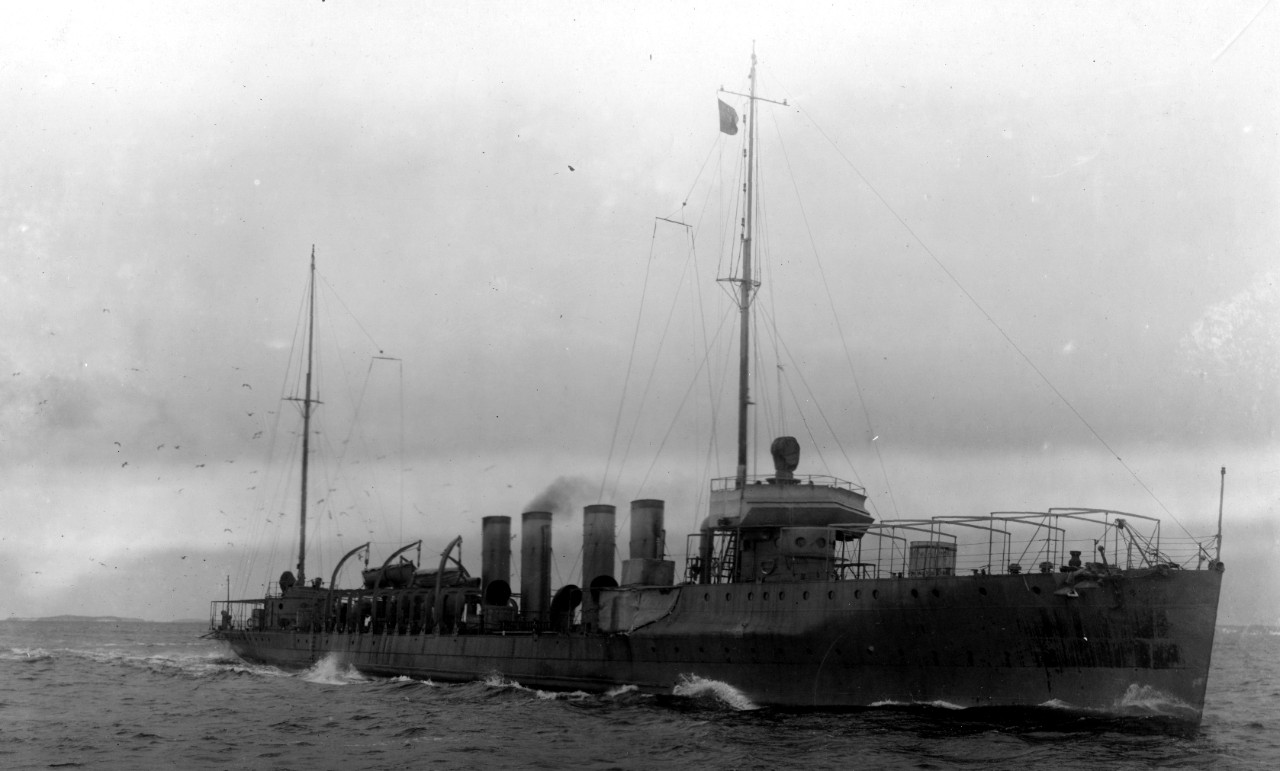
Commissioned at the Philadelphia Navy Yard on 17 April 1916, Lt. Cmdr. Ward K. Wortman in command, Porter received orders to proceed to Newport, R. I., on 8 May 1916. Assigned to the Eighth Division of the Destroyer Flotilla, Porter conducted trials and carried out her shakedown out of that port through the summer.
On 8 October 1916, in the wake of reports reaching Newport that the German submarine U-53 (Kapitänleutnant Hans Rose in command) was in the process of sinking five foreign merchant vessels off the Massachusetts coast, the new destroyer stood out to assist with the recovery of survivors, clearing the port with such alacrity that half of her crew could not rejoin her before she sailed. U-53 stopped the 4,850-ton Dutch steamer Blommersdijk, bound for Rotterdam with a cargo of wheat, and the 3,449-ton British passenger steamer Stephano, en route from St. John’s, Newfoundland, to New York City before Porter reached the area. Kapitänleutnant Rose allowed the neutral U.S. destroyers arriving on the scene to evacuate the merchantmen before he sank them.
Porter arrived on the scene at 5:30 p.m. and located the British steamer, and found that Balch (Destroyer No. 50) and Ericsson (Destroyer No.56) were already at work evacuating her crew. Porter’s searchlight provided illumination for the humanitarian work throughout the dog watches until the senior officer in Balch sent her to look for the crew of a previously sunk vessel. She returned to Newport on 9 October only to be sent out again as part of a scouting line to search for survivors, returning a little over a half hour into the mid watch on 11 October. No crewmembers on board the merchantmen perished -- due in part to the efforts of the U.S. destroyermen.
Porter then patrolled the Caribbean (15 January - 23 March 1917). On 25 March, the Atlantic Fleet received orders to assemble in Chesapeake Bay, taking station in the York River. On 6 April 1917, Congress declared war on Germany, formally bringing the U.S. into the World War. Porter arrived in the York River two days later, and on 11 April she escorted the French cruiser Jeanne d’Arc to Annapolis, Maryland.
The Secretary of the Navy ordered Division Eight of the Destroyer Force, including Porter, to prepare for distant service. On 14 April 1917, Porter stood out for Boston arriving on 16 April where she put into dry dock. On 24 April, crews finished work on the vessel, she finished taking on supplies, and cleared Boston in company with McDougal (Destroyer No. 54), Conyngham (Destroyer No. 58), Wainwright (Destroyer No. 62), Davis (Destroyer No. 65) and Wadsworth (Destroyer No. 60). After his ship reached a point 50 miles east of Cape Cod, Cmdr. Joseph K. Taussig, the division commander in Wadsworth, opened his sealed orders that directed him to lead the six destroyers to Queenstown [Cobh], Ireland. Porter and her division would be the first U.S. warships deployed to European waters during the World War.
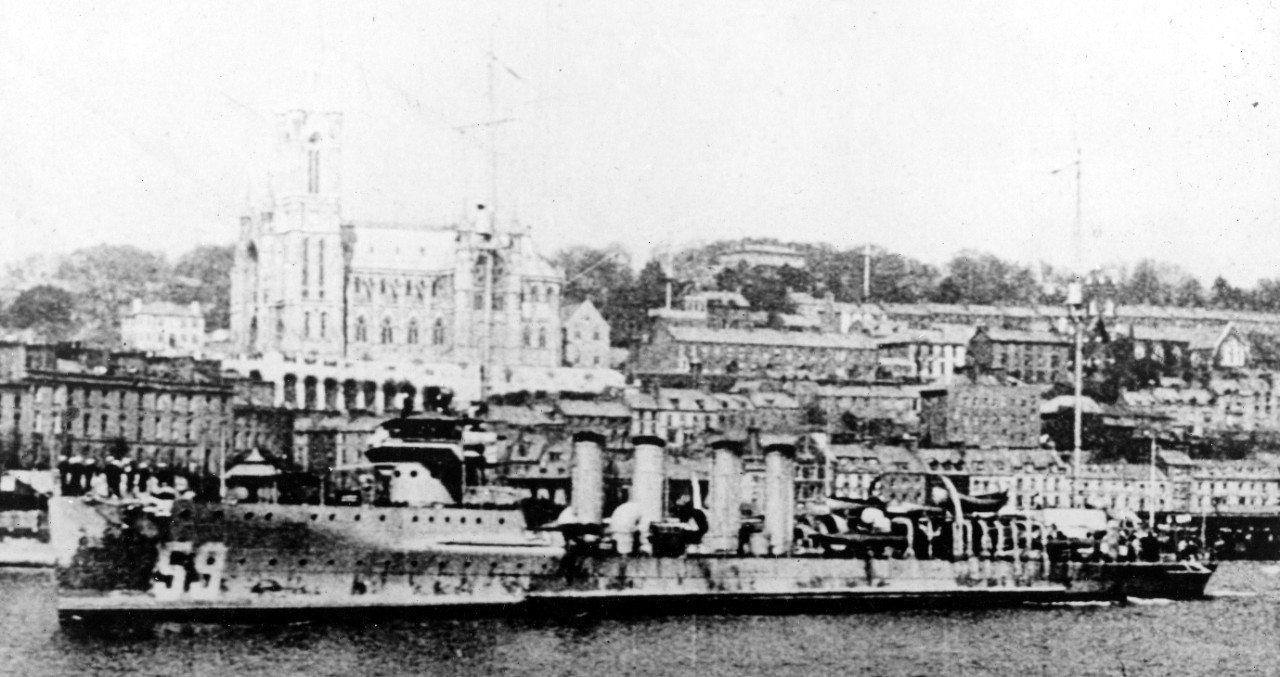
Taussig’s ships completed their transatlantic voyage on 4 May 1917 and the British destroyer HMS Mary Rose escorted them into port at 12:45 p.m., where Cmdr. Taussig met with Rear Adm. Lewis Bayly, the commanding officer of Queenstown, who asked: “When will you be ready to go to sea?” Taussig replied: “We are ready now, sir, that is, as soon we refuel.” While the Americans might have been ready, their ships needed to be re-equipped to enable them to carry out the work to which they would be assigned. Over the next few days the U.S. ships loaded depth charges and apparatus for employing them.
On 8 May 1917, Porter stood out from Queenstown on her first patrol. She assisted the British steamer Nyassa after she caught fire, escorting her to Berehaven. While escorting the former White Star Liner Celtic on 17 May, the destroyer saw a torpedo wake pass 1,000 yards astern of her massive charge. Later, a minor collision with Celtic in dense fog bent Porter’s stem but the damage did not prevent the destroyer from completing her escort mission and continue patrolling.
While en route to St. Nazaire, France, on 7 July 1917, Porter recovered the captain and twelve survivors of the Norwegian steamer Snetoppen, sunk by UC-71 (Oberleutnant zur See Reinhold Saltzwedel) three days earlier. The destroyer arrived at St. Nazaire later that day and disembarked the survivors. Later, on 29 July, Porter struck a submerged object with considerable force although inspection revealed no significant damage. On 6 August, she entered dry dock for repairs and alterations that were completed on 19 August, and she resumed patrol and convoy duty the next day.
While escorting St. Louis (Cruiser No. 20), which had the Commander-in-Chief of the Atlantic Fleet on board, Porter encountered heavy seas on her starboard bow that carried away many unattached pieces of equipment, damaged the deck and bulkheads, and flooded some compartments below. The damage, however, did not affect the vessel’s seaworthiness and Porter continued to support convoy operations for another week before tying up for her routine weekly upkeep.
On 15 October 1917, Porter was nearby when a torpedo from U-61 (Kapitänleutnant Victor Dieckmann) struck Cassin (Destroyer No. 43) at 1:54 p.m., tearing off her rudder and disabling her. Initially the commander of Porter believed that the explosion had occurred fifty feet astern of Cassin and was unaware of the torpedoing. After intercepting a wireless transmission from the damaged destroyer to Queenstown, Porter realized that a U-boat lay in proximity and hunted for five miles east and south of the disabled vessel without result. She then stood by Cassin as two trawlers arrived to tow her to Queenstown for repairs.
Porter broke out the pennant of the eighth destroyer division commander after Cmdr. Taussig left the division in November 1917 and Cmdr. Wortman succeeded him. Her stint as the division flagship, however, proved short, for on 2 December, Cmdr. Wortman was detached from Porter and hauled down the division pennant. Lt. Ames Loder took temporary command until Lt. Cmdr. William H. Lee relieved him on 14 December.
Porter arrived at Cammell & Laird Shipping Co. shipyard in Liverpool, England, three days into 1918 and entered dry dock. She remained drydocked until 15 January, when she finished her overhaul and stood out to return to Queenstown.
Porter was zigzagging in front of her convoy at the end of the first dog watch on 3 April 1918 when the lookout reported a suspicious object 1,000 yards off the port beam. The destroyer closed on the spot of the sighting at full speed. An officer on the bridge claimed to see dark outlines in the water after the ship arrived in the vicinity of the sighting, and she dropped a pattern of three depth charges, two from the Thorneycroft depth charge projectors and one off the stern. Porter doubled back to observe any results, noticing a three-foot board floating on the surface unobserved earlier. The commander concluded that the pattern either destroyed or seriously damaged a U-boat. After reviewing the claim following the war, however, the Admiralty disagreed and ruled that no submarines were in the vicinity on 3 April 1918.
Six days later, on 9 April 1918, Porter was steaming to Liverpool to rendezvous with the troop transport Leviathan (Id. No. 1326), when she noticed an unexplained oil slick. She dropped a pattern of depth charges on the slick due to reports she had earlier received about a submarine hunting in the vicinity. The crew did not observe any results. The destroyer continued to Liverpool where she met her charge on 10 April.
The eventful month of April ended in a running battle with a German sub. While steaming on escort duty at 8:46 p.m. on 28 April 1918 Porter spotted an unmistakable periscope and submarine wake 1,000 yards on her starboard bow. The adversary was closing on the convoy. In a considerable feat for a destroyer in World War I, she was able to close within 40 yards of the surfaced sub before the enemy vessel submerged in haste. Following the war, U.S. authorities received the U-boat’s log which states that Porter’s “dazzle” camouflage scheme and the gathering darkness caused the U-boat commander to overestimate the adversary’s distance. Porter pounced on the opportunity and dropped a barrage of 23 depth charges on the spot and its immediate surroundings. She completed her work at 8:54 p.m. and waited for daylight to gauge the success of the attack.
Toward the end of the morning watch on 29 April 1918, Porter returned to the scene of the engagement where her men noticed several oil patches and various small pieces of wreckage. In particular the officers noticed a slate-colored box. The evidence led the officers on board Porter to conclude that they had destroyed the submarine. British intelligence, however, revealed that while the depth charge pattern badly damaged German submarine U-108 (Korvettenkapitän Martin Nitzsche) she survived the incident. The attack succeeded in ending the submarine’s patrol, however, and keeping her away from allied shipping lanes for two more months. Porter detonated a potentially dangerous drifting mine with small arms fire at 9:13 a.m. and then dropped three depth charges on the wake of a submerged object at 11:42 a.m. with no observed results.
On 1 May 1918, Lt. Cmdr. Arie A. Corwin relieved Lt. Cmdr. William H. Lee. Two days later Porter dropped a pattern of three depth charges on an oil slick. British dock workers replaced her propellers in dry dock at Queenstown (6-9 May) and a minor fire broke out on board during that time (7 May). Two of Porter’s charges, the British steamships Eskasonia and Midway collided en route to Liverpool at the beginning of mid watch on 14 May. Porter closed on the ships which were stuck together, but after some maneuvering Eskasonia freed herself from her predicament and Porter escorted Midway to Cardiff, Wales. After handing Midway off to another escort, the destroyer went to general quarters at 4:54 p.m., and closed on a suspicious wake, dropping twenty depth charges after reaching the vicinity.
Five destroyers, including Porter, were transferred from Queenstown to the port of Brest on 9 June 1918 to assist convoys near the French coast. Shortly after beginning operations out of that place, she went to general quarters at 10:55 a.m. on 13 June 1918 after sighting a submarine on the surface 7,000 yards away on the starboard bow. She closed at full speed at the submarine which did not submerge ahead of the charging destroyer. Lt. Cmdr. Corwin withheld fire due to the fact that the vessel looked like a French submarine – a decision that proved fortunate. When the destroyer approached within 2,000 yards she noted the boat’s colors were flying and signal flags arranged in the daily “demand” or password. Corwin later complained to the allied command that the submarine’s commanding officer neglected using other signal mechanisms such as rockets or grenades that would have identified her at a greater distance.
Porter and six fellow American destroyers were escorting an outgoing troop convoy on 1 July 1918. At 9:11 p.m., U-86 (Oberleutnant Helmut Patzig) torpedoed Covington (Id. No. 1409), stopping her dead in the water. Porter spotted an oil slick and dropped eight depth charges on it, then circled the stricken troop transport and offered assistance. The other escorts were able to rescue the surviving crew and passengers and Porter continued on with the convoy.
Porter received a new commander on 22 July 1918 when Lt. James T. Alexander relieved Lt. Cmdr. Corwin. While on a scouting line at 4:45 p.m. on 8 August, searching for her assigned convoy, she passed several lifeboats carrying survivors of the French armored cruiser Dupetit-thouars, which had been sunk by U-62 (Kapitänleutnant Ernst Hashagen) the previous day. The Americans took on board the commanding officer, six officers and 137 enlisted French sailors. Three days later, after Porter had located the convoy, Conner (Destroyer No. 72), one of the newer “flush deck” destroyers, spotted a submarine and raised an alarm. Porter and Drayton (Destroyer No. 23) dropped depth charges. Porter expended five and witnessed no results. She again steamed to Liverpool for repairs and overhaul at Cammell & Laird yard, Liverpool, on 15 August, completing work on 23 August.
Lookouts spotted a suspicious wake on the port beam on 27 September 1918. Porter turned to port and closed on the sighting at full speed, then dropped a barrage of 10 depth charges upon arrival but did not notice any results. She continued to operate out of Brest up to the armistice that ended hostilities on 11 November 1918.
Porter began regularly transporting passengers from Brest to Plymouth, England, on 28 November 1918, and four days before Christmas of 1918 [21 December] Porter and the U.S. destroyers at Brest sailed for the U.S., touching at the Azores and the Bahamas before reached the Boston Navy Yard on 8 January 1919. Porter remained moored alongside Pier 4-A from February to June, and on 17 July 1920 was reclassified from Destroyer No. 59 to DD-59. In September, she was sent to the Philadelphia Navy Yard for overhaul, where, on 23 June 1922, she was decommissioned.
By 1924, the passage of the 18th Amendment (Prohibition) had spawned a thriving traffic in smuggled alcohol. The Coast Guard's small fleet, charged with stopping the illegal maritime importation, proved unequal to the task. Consequently, President Calvin Coolidge proposed to bolster that fleet with 20 of the Navy’s inactive destroyers, and Congress authorized the necessary funds on 2 April 1924. Adapting those vessels for service was thought to be less costly than building new ships. In the end, however, the rehabilitation of the vessels became a saga in itself because of the exceedingly poor condition of many of the war-weary ships. Additionally, the destroyers were by far the largest and most sophisticated vessels ever operated by the Coast Guard; trained crewmen were nearly non-existent. As a result, Congress subsequently authorized hundreds of new enlisted billets. It was these inexperienced recruits that generally made up the destroyer crews.
Porter was transferred to the Treasury Department, along with other destroyers, for service with the Coast Guard on 7 June 1924. Initially placed under the control of the Coast Guard Receiving Unit at the Philadelphia Navy Yard, Coast Guardsmen and yard workmen overhauled Porter’s hull, stripped her of depth charge gear and torpedo tubes, and replaced her guns. Malcom F. Willoughby noted, “The winter of 1924–25 was exceptionally severe. Work on destroyers went on day after day in close to zero weather often without the vestige of heat. Some boilers and engines were in fairly good condition, while others were in a deplorable state. New, quick-firing, long-range guns were installed; torpedo tubes and Y-guns for depth charges were removed to lighten weight and remove unneeded equipment.”
Maintaining her name, Porter was re-designated CG-7. She conducted trials in the vicinity of Brown’s Shoals, Delaware Bay on 19 February 1925 and upon successful completion was commissioned while underway on 20 February 1925, Lt. Cmdr. LeRoy Reinburg, USCG, in command. After commissioning, she got set course for New London, Conn. Porter later arrived at her permanent duty station, Stapleton, Staten Island, N.Y. and was designated the flagship for Division Two, Destroyer Force. Within a year of her commissioning, Porter conducted exercises for the Gunnery Year 1925-1926. Competing against the former Navy destroyers converted to Coast Guard service and the large cutters, Porter tied for 17th among the 22 ships that conducted a record fire.
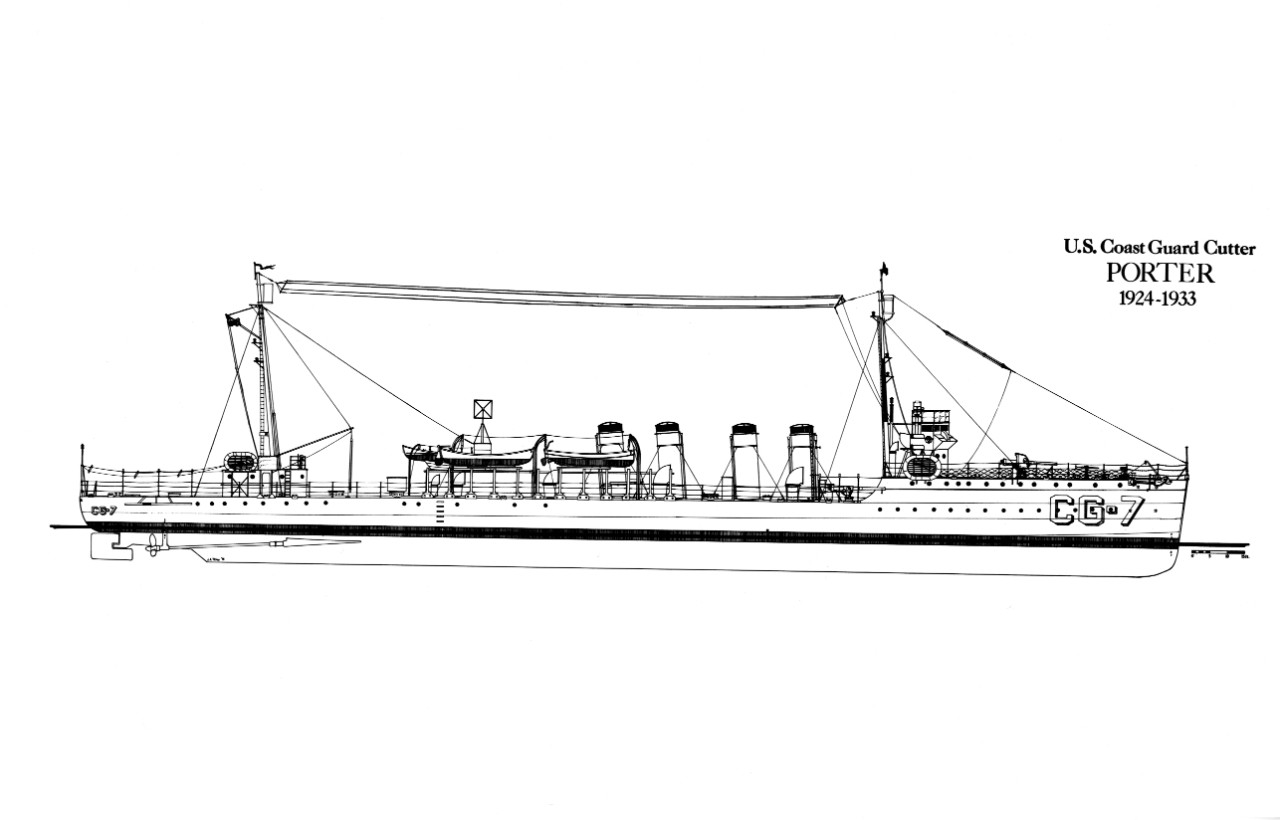
Porter, on 2 March 1926, was patrolling eastward off the southern shore of Long Island when she sighted the French-flagged Mistinguette out of St. Pierre et Miquelon running without lights. The destroyer shone her searchlight on the two-masted schooner which caused her to turn southward in an attempt to run. Porter overtook her after a short pursuit and deployed a boarding party that found over 3,000 bottles of liquor on board and arrested the 10-man crew. The latter subsequently divulged their plan to offload their cargo at a point 20 miles off Montauk Point. Placing a prize crew on board, Porter escorted the rumrunner into New York and anchored off the Statue of Liberty the next day. A few weeks later, on 22 March, Porter seized the schooner Robert C. Clowry with about 5,000 cases of liquor on board. On 21 June, Porter reported to the New York Navy Yard for drydocking and a maintenance availability.
Later that year, Porter was again on patrol on 29 November 1926. This time cruising off the entrance to Long Island Sound, she sighted the two masted auxiliary schooner yacht Consuelo II out of New York. The vessel appeared to be heavily laden, so the destroyer trailed her until she reached sheltered waters. About two miles north of Little Gull Island, Porter overhauled the schooner which hove-to on orders. The boarding officer discovered liquor on board along with poorly forged documents. In truth, no documents had ever been issued to a vessel named Consuelo II. She was, in truth, the yacht Louise, a former pilot boat from Boston, Mass. The vessel was seized with her cargo. The destroyer took the rumrunner in tow, and while en route turned her over to the 100-foot patrol boat Perry out of New London, Conn., which towed her into New York and turned her over to customs officials. Upon further inspection, over 2,200 bottles of alcohol were found on board in holds hidden by concrete flooring. The Coast Guard was so impressed by the excellent condition of the “black ship” that she was taken over and brought into government service as the patrol boat CG-806.
Porter, as flagship, conducted a battle practice cruise with Division Two (9-13 1927). After conducting that training, Porter conducted her routine patrol. Later, on 29 July, she departed Stapleton with stores for New London. Arriving that same day, she discharged her gear and then headed to Nobska Point, Mass., to receive two passengers. Having taken them on board, she delivered both to Base 18 at Gloucester, Mass., early the next day. She then proceeded to sea in company with Patterson (CG-16) on 2 August and fired her short range battle practice for the Gunnery Year 1927-1928. The next day, 3 August, she departed Gloucester and proceeded to patrol her designated sector.
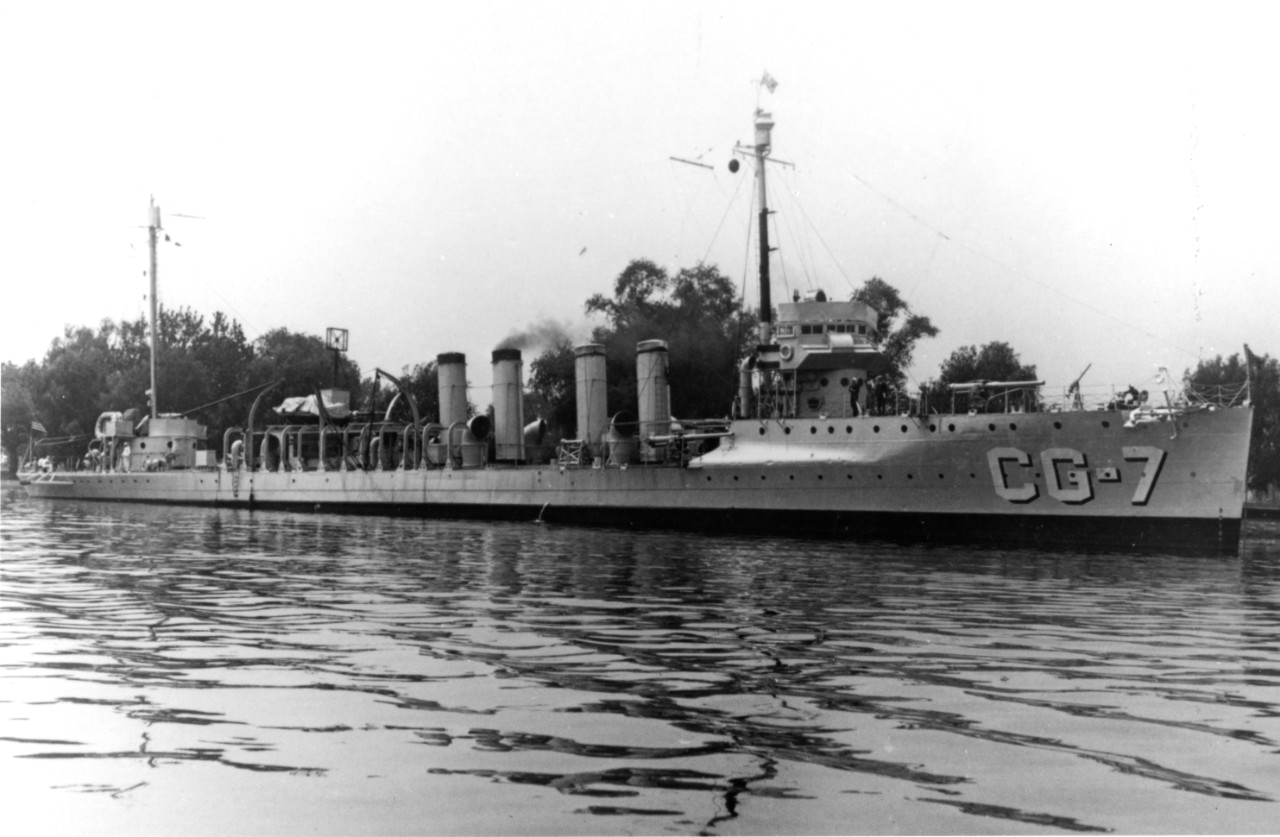
Porter arrived at the Marine Corps Recruit Depot, Parris Island, S.C., on 15 May 1928, so her crew could receive small arms instruction and conduct training on the depot’s ranges, upon completion of which she sailed for Norfolk, Va., on 5 June. Arriving the next day, she remained until 8 June when she passed between the Virginia capes en route to New London, Conn. Coast Guard Commandant Rear Adm. Frederick C. Billard visited Division Two, Destroyer Force at Stapleton on 16 August 1928 and commended Lt. Cmdr. Stephen S. Yeandle, commanding officer of Porter, the division’s commander, for the appearance of the men and ships under his command. That standard of achievement, however, was not replicated when the ship conducted her battle practices for the Gunnery Year 1928-1929. Placing 16th in the short-range battle practice and 14th in the long-range, Porter stood 19th overall among the 24 destroyers in that year’s competition. A year later, the ship performed likewise, rating only 15th among the 19 destroyers in the Gunnery Year 1929-1930 competition.
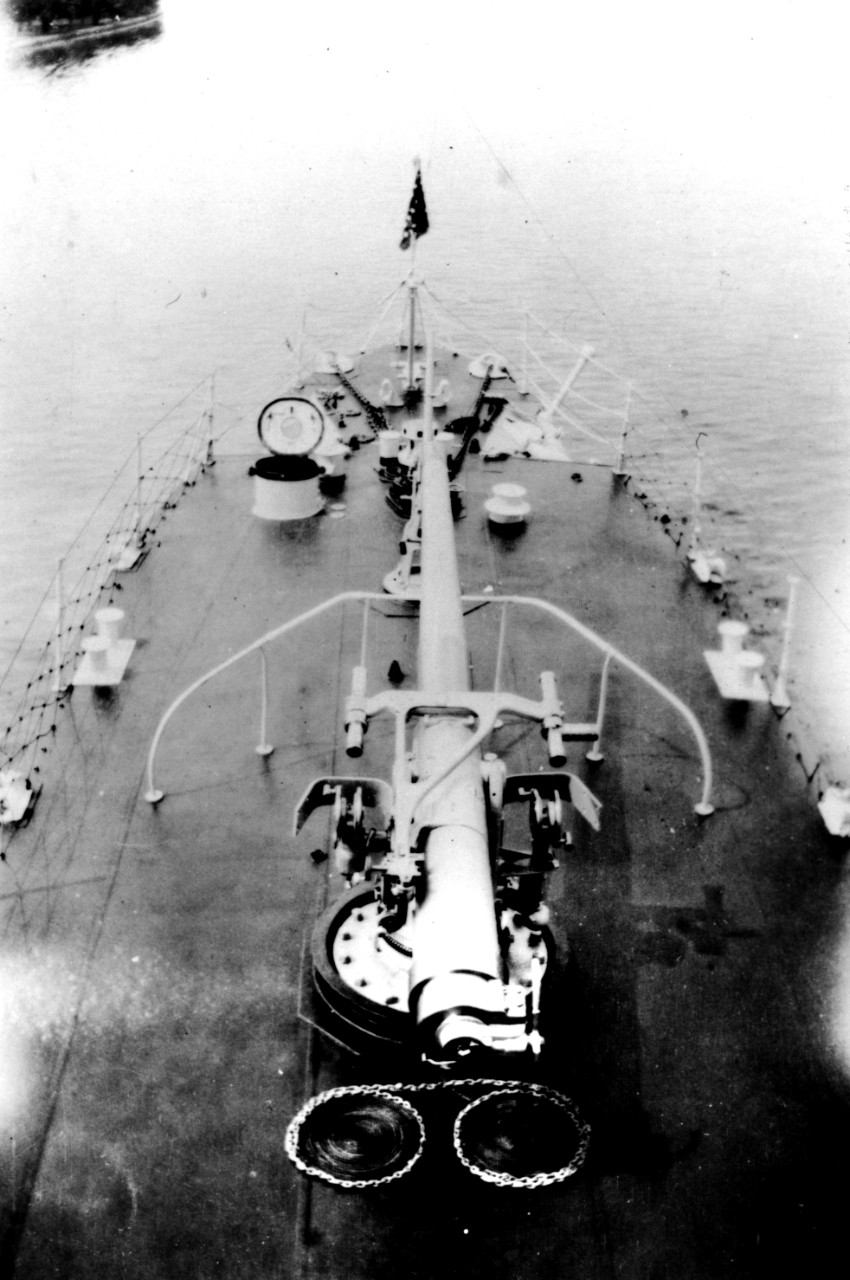
Porter seized the British-flagged motor vessel Good Luck 10 miles off the coast of the U.S. on 23 November 1930. Towing her into Providence, R. I., Porter turned her over to the Collector of Customs for adjudication. This seizure prompted a correspondence between the State Department and Canadian officials. A few days later, on 26 November, Porter stood by the schooner Storm Petrel in a gale and rough seas off Six Mile Reef in Long Island Sound. The 125-foot Active-class patrol boat Vigilant, based at Stapleton, also responded and assisted the destroyer in attempting to tow the schooner.
While underway on 11 January 1931, Porter struck a submerged object west of Shagwong Reef in Long Island Sound forcing her into New London with a damaged bottom. The incident resulted in the convening of a board of investigation. Her improved performance in the exercises for Gunnery Year 1931-1931, however, countered that unfortunate incident, as that year’s competition saw Porter improve to the upper half of the table, standing 6th among the 13 destroyers in the shoot.
Later in the year, while on patrol on 13 August 1931, Porter, assisted by the 75-foot patrol boat CG-289, overtook Greyhound, out of Gloucester. Seizing her for “resisting a revenue officer, failure to halt for search, and running without lights after sunset,” Porter took the offender into Section Base Four at New London. A month later, on 15 September, Porter rendezvoused with Hunt (CG-18) and Abel P. Upshur (CG-15) then scouted into Area Baker-Three. She encountered Apohaqui, out of St. Johns, Newfoundland, and began trailing her. With the approach of darkness, however, the destroyer’s searchlight failed and Porter lost contact with the rumrunner.
The ship was selected, on 30 November 1931, along with fellow destroyers, Welborn C. Wood (CG-19), Herndon (CG-17), and Tucker (CG-23) to visit Washington, D.C. for a football game. She arrived at the Washington Navy Yard on 4 December. Later in the month, on 28 December, three days after Christmas, she assisted the trawler Kingfisher ashore near Watch Hill Light, R.I. Afterward, she set a course for New York enroute to the New York Navy Yard, arriving on 30 December.
While Porter maintained her position in the top half of the standings, again rating 6th overall in the destroyer gunnery exercises for Gunnery Year 1931-1932, that performance would fall off markedly in the following year’s record shoots. Porter finished last among the six destroyers in the competition. Ironically, however, during the small arms qualifications for her crew for Gunnery Year 1932-1933, Porter ranked first in the Destroyer Force.
Ultimately, Porter’s grueling anti-smuggling interdiction duties off the Eastern seaboard wore upon her and she, along with her fellow former-Navy destroyers, had become unfit for service. Ordered detached from the Destroyer Force and assigned to the command of the Coast Guard Representative, Philadelphia Navy Yard, she arrived at Philadelphia on 26 May 1933. Decommissioned at Philadelphia on 5 June 1933 along with Tucker, Davis (CG-21), Shaw (CG-22), McDougal (CG-6), Cassin (CG-1), and Conyngham (CG-2), Porter was returned to the Navy on 30 June.
Porter gave up her name to new construction on 1 July 1933 and was known simply as DD-59. She remained in reserve at Philadelphia into 1934. DD-59 was stricken from the Navy list on 5 July 1934 and sold for scrapping to Michael Flynn, Inc., of Brooklyn, N.Y., on 22 August 1934, in accordance with the London Treaty on the Reduction of Naval Armament.
| Commanding Officers | Date Assumed Command |
| Lt. Cmdr. Ward K. Wortman | 17 April 1916 |
| Lt. Ames Loder | 2 December 1917 |
| Lt. Cmdr. William H. Lee | 14 December 1917 |
| Lt. Cmdr. Arie A. Corwin | 1 May 1918 |
| Lt. James T. Alexander | 11 July 1918 |
| Cmdr. Charles S. Kerrick | 20 February 1919 |
| Lt. Cmdr. LeRoy Reinburg, USCG | 20 February 1925 |
| Lt. Cmdr. James L. Ahern, USCG | 30 August 1926 |
| Lt. Cmdr. Stephen S. Yeandle, USCG | 17 April 1928 |
| Lt. Cmdr. Roger C. Heimer, USCG | 10 December 1930 |
| Lt. Cmdr. Carleton T. Smith, USCG | 18 July 1931 |
S. Matthew Cheser, Christopher Havern, Jr., Robert J. Cressman
7 February 2017


